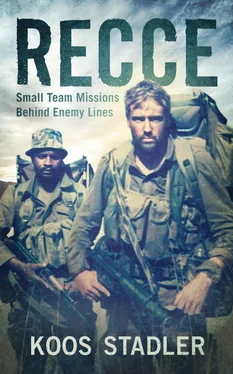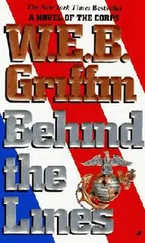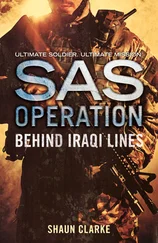Over the next few days the combat group was ordered to conduct area operations, and then to start sweeping south through the areas where we had engaged the enemy earlier on. It was considered too dangerous for our combat group to move any closer to the FAPLA and Cuban deployments in the area of Jamba and Techamutete, since we were essentially a guerrilla force armed only for combat against SWAPO in the bush. We had neither the arms nor the armour to engage tanks or armoured cars in conventional combat. At this point we were also well within range of the FAPLA MiGs operating from Menongue.
Strangely, on our way back to the border, we had a number of skirmishes with stray groups of SWAPO. This might have been because their command and logistics system had been disrupted by the earlier operation, or because the cadres did not know what was happening and had returned to the supply route for replenishment.
One day I was driving behind the HQ package, taking a breather from the stress of driving point and having to be vigilant all the time. The peace was short-lived. “Enemy right!” came the voice over the radio, followed by the sound of AK shots from the side of an omuramba .
I could see the HQ vehicles in front of us being bogged down by enemy fire. A voice cried over the radio, “They’re shooting at me, they’re shooting at me!” while the pressure switch was held down, preventing the rest of the force from communicating. But this didn’t deter us. Without hesitating, we swung into the direction of the incoming fire and charged head on, followed by B Company’s vehicles. In the absence of proper radio comms, the commander of A Company, which was in the rear, had the presence of mind to swing sharply to the right in an attempt to outflank the enemy and cut them off to the north.
The recce wing vehicles arrived simultaneously at the enemy positions, which by then had already been vacated. The ambush had been set up with well-prepared firing positions, good arcs of fire and good escape routes into the thick undergrowth beyond. Unfortunately for the ambushers, a group of about twenty, our combat group passed too far across the omuramba, thus rendering their fire ineffective.
We didn’t waste any time; I took twelve recces onto the tracks into the thick vegetation, leaving the rest to protect our vehicles. We knew from previous experience that the enemy would run for one or two kilometres, slow down to listen, and then try to anti-track or deceive their pursuers by splitting into smaller groups. After three kilometres, they would settle into a steady pace on a route until they reached relative safety. This trick was all too familiar to us, as we had all done it ourselves many times before.
We therefore ran at breakneck speed on the clear tracks left by the running SWAPO soldiers. Soon enough, we found the spot where they had slowed down. From that point on the tracks were not as clear, and soon we could see them dispersing. We continued our chase, knowing that they would expect to hear vehicles first. I spoke to the HQ on the run, requesting choppers as air support and to act as telstar (an aircraft that would be dispatched to establish comms in case of an emergency) once we ran out of comms with the main column.
Contact!
Two SWAPO cadres were leaning leisurely against a tree and drinking from their water bottles when we ran straight into them. We opened fire before they could even put down their bottles. The first one didn’t have a chance and died in his tracks, the other hit the deck and tried to crawl out of the field of fire, but to no avail. By this time we were like a pack of hounds, hungry for prey. We didn’t stop, but just went on hunting once we had checked that the two cadres had passed on to greener pastures.
We knew that the shots would have alerted their comrades, who would be more vigilant, but we maintained a steady pace on the three or four tracks we were following. Suddenly the lead pilot of two Alouettes came on the air, calling for our position and ID. They had been on their way to our combat group when the call for assistance came through and were therefore instantly ready for action.
We gave them yellow smoke on the ground and I quickly briefed them over the radio. On the run I gave the choppers a compass bearing of the direction the enemy was heading. While one chopper circled overhead and maintained a close air support posture for our group, the other flew on the bearing and circled two to three kilometres further ahead in an effort to locate the fleeing enemy and also to keep their heads down. It wasn’t long before we found where the cadres had been ducking and hugging trees as the chopper swept over them, trying to hide from the prying eyes of the crew.
When the 20-mm machine gun of the lead chopper started stuttering its deadly song, we knew we were onto them. We spread out wide, sweeping vigilantly through the thick undergrowth. The helicopter in the close air support role engaged, kicking up plumes of sand barely 30 m ahead.
I heard someone shout: “He’s shooting… he’s shooting! Down!”
In that instant I saw a SWAPO soldier taking aim at one of my team buddies from behind a fallen log. Our man was virtually on top of him, but didn’t have time to train his weapon on the cadre at his feet. Instead, he just rushed at him like someone possessed, jumped the log and kicked the AK-47 from the wounded terr’s hands, all in one mad, wild move. The rest of the team then opened up, killing the cadre instantly.
By now we were all fairly wasted, having run about twelve kilometres at almost full speed. We quickly regrouped in all-round defence and I ordered the Bushmen to find the rest of the tracks. The lead pilot reported that they were low on fuel and had to return to the combat group, but promised that they would be back with water. Soon it became apparent that the remaining two or three insurgents had dispersed and were now running individually. There would be no sense in following one track at a time, especially since the cadres had been given the fright of their lives and were now probably doing some serious low flying through the bush.
We started our withdrawal, exhausted and thirsty, but happy with the day’s work, knowing that we had achieved the almost impossible: we had outrun fleeing SWAPO soldiers on their own turf. The choppers soon returned with our water, and the pilot was kind enough to talk us back to the vehicle column via an easy route.
During Operation Protea two mechanised combat groups had led the attack on Angolan forces at Ongiva. The town had been left in a shambles. All FAPLA elements had evacuated their positions, the town’s administration had been completely disrupted and the population were battling to survive. Command of the salvage operation in town, as well as the defensive positions around the perimeter, was given to 31 Battalion. The whole unit converged on Ongiva and established a TB some 20 km to the southwest, from where mopping-up actions would be conducted. The unit had the unenviable task of systematically working through the abandoned FAPLA defences to collect remaining weapons and documentation, as well as to destroy bunkers, infrastructure and any foreign ammunition not used during the battle.
Although I was not keen on the job and did not want the recce teams to be exposed to the relaxed atmosphere and relative ill-discipline of the regular troops, it did offer us a well-deserved break while still attuned to the war. In the end it was a great experience, as we got to know our brethren from the companies more intimately, and generally had a pleasant time at the HQ in the bush. To keep their hand in, the recce teams did security patrols around the TB, and often found the familiar chevron tracks, a spoor pattern commonly used by SWAPO cadres, in the vicinity of the camp – just to keep the hair on our necks standing up.
Читать дальше












